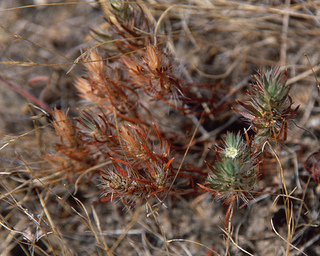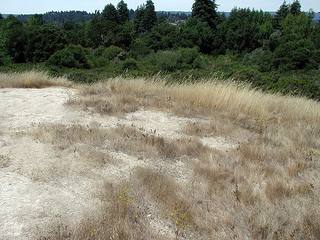(Polygonum hickmanii)
 Polygonum hickmanii. CDFW photo by Mary Ann Showers.
Polygonum hickmanii. CDFW photo by Mary Ann Showers.
 Polygonum hickmanii habitat. CDFW photo by Mary Ann Showers
Polygonum hickmanii habitat. CDFW photo by Mary Ann Showers
Scotts Valley polygonum is a California endangered plant species, which means that killing or possessing the plant is prohibited by the California Endangered Species Act (CESA). The species is also listed as endangered under the federal Endangered Species Act(opens in new tab). Scotts Valley polygonum is a one- to two-inch tall annual plant that has only been found at two sites in Scotts Valley of Santa Cruz County. Within these sites, seventeen colonies have been recorded. Although an ongoing monitoring program for all colonies has not been implemented, rangewide surveys were conducted in five different years. During these surveys, the highest number of individuals recorded was approximately 3,412 plants in 1998, and the lowest was approximately 300 plants in 1991 and 1992. The total area inhabited by the plant is estimated to be less than one acre. Scotts Valley polygonum grows in habitat with a very limited distribution. It has been found in the thin soil of certain gently-sloping to nearly-level rock outcrops within areas of annual grassland. Scotts Valley polygonum begins producing white flowers in May and may continue flowering into October or until conditions are no longer favorable.
Scotts Valley polygonum is at risk of extinction because of its small and localized colonies, and because all of the known plants occur near urban areas. One colony is fenced and preserved at the Scotts Valley High School Preserve; however, it is surrounded by development on three sides and could continue to be impacted from the surrounding land use. All of the known Scotts Valley polygonum populations also continue to be threatened by the direct and indirect impacts of proposed and existing development. Colonies of the species are at risk of extirpation due to their small sizes and the highly fragmented and disturbed nature of the habitat. Competition from native and non-native plant species and recreational use of habitat are also threats to the species. Climate change could also negatively affect Scotts Valley polygonum in the future.
Efforts should be made to protect and manage the remaining Scotts Valley polygonum habitat for the benefit of the species near Scotts Valley High School, and especially at Polo Ranch, where the ecosystem is considered to be the most intact. These lands should either be acquired by a conservation organization or they should be protected with conservation easements. Research into the life history, ecology, and population dynamics of the species should be conducted, and all remaining colonies should be monitored. Because Scotts Valley polygonum is so localized and limited to such small colonies, seeds from plants should be appropriately collected for long-term conservation storage and living plants should be maintained in botanic gardens.
CDFWmay issue permits for Scotts Valley polygonum pursuant to CESA, and you can learn more about the California laws protecting Scotts Valley polygonum and other California native plants. Populations of Scotts Valley polygonum occur in CDFW’s Bay Delta Region. More information is also available from the U.S. Fish and Wildlife Service’s Species Profile for Scotts Valley Polygonum.
Updated 01/15/2014